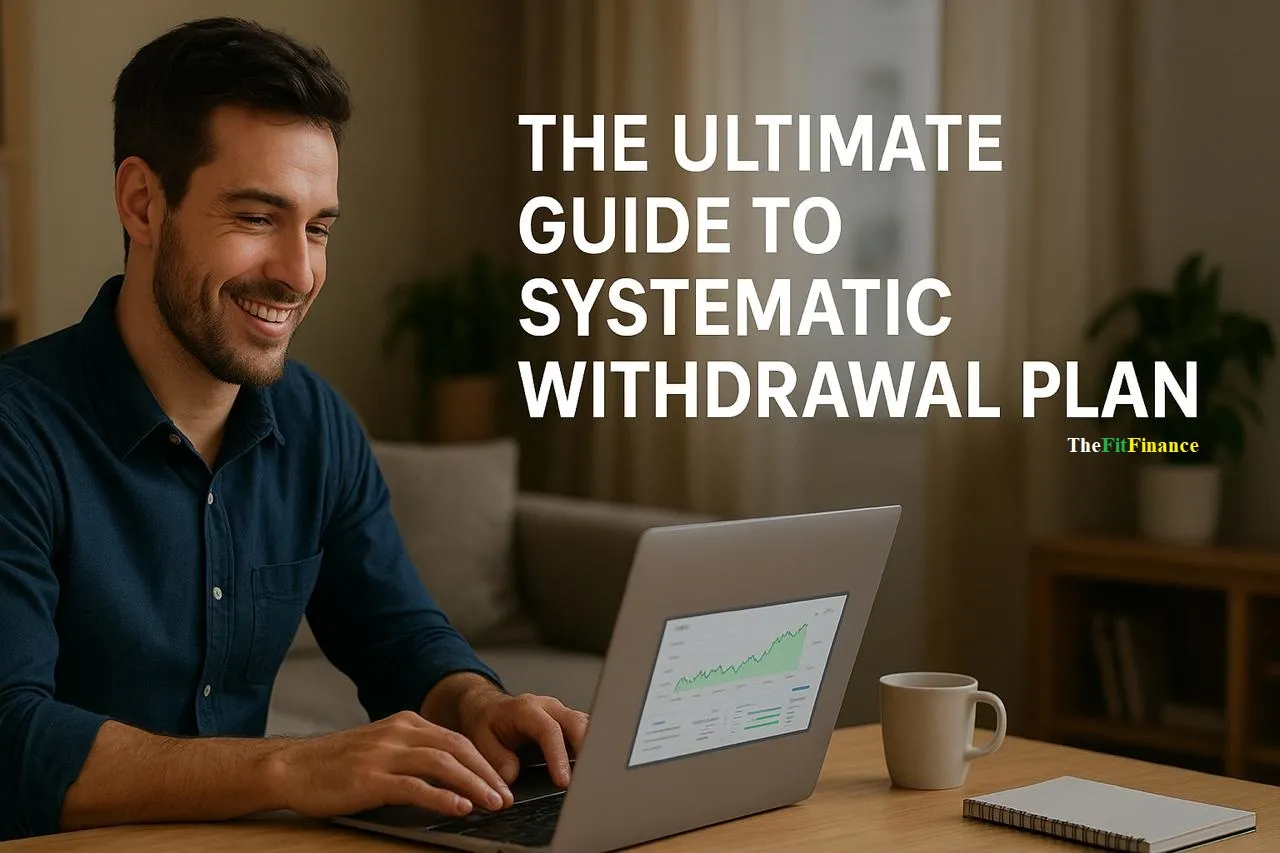Originally Published: February 2025 | Last Updated: September 2025
Your ATM That Never Runs Out
Imagine waking up on the first day of every month to see money credited into your account—not from your employer, not from a side hustle, but from your own investments. Like a personal paycheck that never misses a date. That is not fantasy—it is the power of a Systematic Withdrawal Plan (SWP).
An SWP is one of the most underrated yet powerful tools in personal finance. While most people talk about SIPs (Systematic Investment Plans) for wealth creation, very few explore how to smartly withdraw that wealth without draining it. Whether you are planning for retirement, seeking passive income, or just want a disciplined approach to using your portfolio, SWP can be your best strategy.
By the end, you will know exactly how to make SWP work for you, how to set it up step by step, the benefits compared to other methods, and real-life scenarios where it can transform financial life with maximum returns with minimum risk.
What is a Systematic Withdrawal Plan?
A systematic withdrawal plan (SWP) is an investment strategy that allows you to withdraw a fixed amount from your mutual fund investments at regular intervals—monthly, quarterly, or annually. Think of it as the opposite of SIP: instead of investing regularly, you are withdrawing regularly while your remaining investment keeps growing.
For example, let’s say you invested $200,000 in a balanced mutual fund. Instead of withdrawing it all at once or relying on unpredictable dividends, you can set up an SWP to withdraw $1,000 every month. The best part? The rest of your money continues compounding in the market.

Why Choose a Systematic Withdrawal Plan?
Most investors either:
• Take out lump sums (risking running out of money too soon), or
• Depend on dividends (which are inconsistent and taxable).
A systematic withdrawal plan offers something smarter:
• Regular and predictable income – Like a salary, you know exactly what’s coming in.
• Market volatility protection – Instead of panic selling during crashes, you smartly withdraw in small, planned amounts.
• Tax efficiency – Only the gains are taxed, often at lower long-term capital gains rates.
• Wealth longevity – You take what you need while letting the rest of your money grow.
It is not just a withdrawal method—it’s a smart retirement withdrawal strategy that ensures your portfolio lasts longer.
Who Should Consider an SWP?
SWPs are not just for retirees. They are valuable for anyone who wants financial freedom and disciplined cash flow.
• Retirees – Replace your monthly paycheck with steady income.
• Freelancers and entrepreneurs – Create stability in uncertain income months.
• Early retirees and FIRE enthusiasts – Fund your lifestyle without selling everything.
• Parents – Finance education goals with systematic withdrawals.
• Investors seeking passive income – Turn investments into reliable cash flow.
How Does a Systematic Withdrawal Plan Work?
The process is surprisingly simple:
1. You invest in a mutual fund. Balanced or debt funds are most common for stability.
2. You set your withdrawal amount. For example, $1,000 every month.
3. Your investments keep growing. The unused portion stays invested in the market.
4. You receive regular payouts. Money lands in your account just like a salary.
It’s essentially turning your portfolio into your own personal ATM—without the risk of it running dry too fast.
How to Set Up Your Own SWP – Step-by-Step Guide
Setting up an Systematic Withdrawal Plan is not rocket science — but it does require smart planning. Here’s a foolproof, step-by-step roadmap:
Step 1: Choose the Right Mutual Fund
Your SWP is only as strong as the fund you pick. Not all funds are safe for steady withdrawals.
# Go for Stability First
Debt Funds→ Less volatile, protect your capital.
Hybrid/Balanced Funds→ Mix of equity + debt for growth + safety.
# Check Track Record
Look for consistent performance over 5–10 years.
Avoid chasing “last year’s best performer.”
# Focus on Costs
Choose a low expense ratio fund.
Every 0.5% saved on costs = thousands more in your pocket long term.
Pro Tip: Do not use pure equity funds for SWP if you want stability. Use them only if you can tolerate volatility.
Step 2: Decide Your Monthly Withdrawal Amount
This is where most investors go wrong — they either withdraw too much (risking depletion) or too little (living below potential).
Use the Safe SWP Formula:
Ideal SWP = Total Investment ÷ (Years Required × 12)
Example:
You want $1,000 per month for 20 years.
Required investment = $240,000 (assuming moderate market growth).

The 4% – 5% Withdrawal Rule for SWP
One of the simplest ways to decide your Systematic Withdrawal Plan (SWP) amount is by using the safe withdrawal rule.
What it means:
You withdraw only 4% to 5% of your total portfolio value per year, adjusted for inflation. This way, your money lasts 20–30+ years, because the remaining amount continues to grow.
Formula:
Annual SWP = Portfolio Value × 4% (or 5%)
Monthly SWP = (Portfolio Value × 4%) ÷ 12
Example (4% Rule):
If you have a portfolio of $500,000,
# Annual withdrawal = $500,000 × 4% = $20,000
# Monthly withdrawal = $20,000 ÷ 12 ≈ $1,667/month
Why 4%–5% works:
# It balances income vs longevity of your wealth.
# Your investments still earn returns while you withdraw.
# It reduces the risk of your portfolio drying up too soon.
⚡ Pro Tip: Use 4% if you want maximum safety (long-term retirement) and 5% if you’re comfortable with slightly more risk or have other income sources.
Step 3: Set Up Your Withdrawal Plan
Once you’ve chosen the fund and amount, it’s time to lock in the plan.
Your fund house will let you decide:
# Frequency– Monthly (most popular), Quarterly, or Yearly.
# Start Date– Pick a date that aligns with your cash flow needs (like the 1st of every month).
# Withdrawal Amount– Fixed (steady income) or variable (linked to fund performance).
Pro Tip: Start with a smaller withdrawal than you think you need. It gives your portfolio room to grow and cushions against market dips.
Step 4: Track & Adjust Annually
An SWP is not a “set and forget” strategy. Markets change, and so will your lifestyle expenses.
Review at least once a year:
# Is your withdrawal % still within safe limits?
# Has inflation increased your monthly needs?
# Is your fund still performing well, or should you switch?
Pro Tip: Think of your SWP like a health check-up — an annual review keeps it fit for the long run.
Step 5: Optimize for Taxes
One of the biggest advantages of SWP is tax efficiency— but only if you play it smart.
Key Rules to Remember:
Equity Funds→ Gains after 1 year taxed at 10% (LTCG)above exemption limit.
Debt Funds→ Best if held 3+ years(tax-efficient long-term capital gains).
Withdraw Smartly→ Stay within lower tax slabs by planning annual withdrawals.
Pro Tip: Do not withdraw extra “just in case.” Every unnecessary withdrawal could push you into a higher tax bracket.
## Bottom Line:
A successful SWP = the right fund + safe withdrawal % + annual review + tax-smart planning.
Done right, it’s like having your own ATM that never runs out, giving you peace of mind and financial freedom.
SWP vs SIP: What’s the Difference?
People often confuse the two because they sound similar. Here’s the difference:
• SIP (Systematic Investment Plan) – You invest small amounts regularly to build wealth.
• SWP (Systematic Withdrawal Plan) – You withdraw small amounts regularly to use that wealth.
Think of SIP as planting seeds and SWP as harvesting fruits. One builds, the other sustains. Ideally, you should do both: SIP during your working years, and SWP once you need income.
Benefits of a Systematic Withdrawal Plan Over Other Options
SWP vs Lump Sum Withdrawals
• Lump sums risk draining your portfolio too quickly.
• SWP gives you a structured, long-lasting income flow.
SWP vs Dividends
• Dividends are unpredictable and can fluctuate.
• SWP gives you complete control over how much you withdraw.
SWP vs Fixed Deposits
• FDs tax interest at your income tax slab rate.
• SWPs only tax capital gains, often at lower rates.
SWP for Retirement Planning
When paired with other retirement strategies, an SWP becomes one of the safest and most flexible ways to withdraw from mutual funds.
Real-Life Scenarios Where SWP Shines;
• The Early Retiree
Lisa, 42, retired early with a $1.5M portfolio. She set up an SWP to withdraw $3,500 monthly, funding her travel lifestyle while keeping her investments intact.
• The Freelance Buffer
Amar, a freelance consultant, uses an SWP to draw $1,500 per month when client payments are delayed. This provides stability in an otherwise unpredictable career.
• The Education Planner
Nina set up an SWP to fund her daughter’s college fees—$2,000 monthly for 4 years. Instead of loans, she tapped her investments systematically.
Each case shows that SWP is not just about retirement—it’s about flexibility, freedom, and peace of mind.
Interactive Element: Find Your SWP Style
Ask yourself: Which goal fits you best?
A) Steady income for daily living.
B) Short-term goal like education or travel.
C) Backup cash flow for emergencies.
Your answer helps decide how aggressive or conservative your SWP should be.

FAQs on Systematic Withdrawal Plans (SWP)
Q1: How to set up a systematic withdrawal plan for beginners?
Start by choosing a stable mutual fund (debt or hybrid funds are common). Decide your safe withdrawal amount using either the formula or the 4% rule, and instruct your fund house to automate payouts monthly, quarterly, or yearly. Always begin with a smaller percentage and review annually.
Q2: Is an SWP good for passive income?
Yes. An SWP is one of the best strategies for creating predictable passive income. Unlike dividends or ad-hoc withdrawals, it gives you fixed, scheduled payouts while your investments continue compounding in the background.
Q3: Can I change my withdrawal amount later?
Absolutely. SWPs are flexible—you can increase, decrease, pause, or stop withdrawals anytime. This makes them perfect for adjusting to lifestyle changes, inflation, or emergencies.
Q4: Can I directly start SWP?
Yes, but with a caveat. Ideally, you should allow your investment corpus to grow for a few years before starting withdrawals. However, if you already have a lump sum or retirement fund, you can begin SWP immediately by choosing the withdrawal frequency and amount.
Q5: Is a systematic withdrawal plan safe during market crashes?
Safer than lump sum withdrawals. With SWP, you only withdraw a small, fixed portion, while the remaining portfolio stays invested for long-term recovery. Pairing SWP with debt/hybrid funds also cushions volatility.
Q6: What’s better—Systematic Withdrawal Plan or withdraw when needed?
Withdraw-when-needed may feel flexible, but it often leads to poor discipline and overspending. SWP, on the other hand, creates structured cash flow (like a paycheck), helping money last longer and reducing emotional investing mistakes.
Q7: What is the difference between a Periodic Investment Plan (SIP) and a Systematic Withdrawal Plan (SWP)?
- SIP (Systematic Investment Plan): You invest small amounts regularly to grow wealth.
- SWP (Systematic Withdrawal Plan): You withdraw small amounts regularly to use that wealth.
Think of SIP as sowing seeds, and SWP as harvesting fruits.
Q8: How to avoid tax on SWP?
You cannot avoid tax completely, but you can reduce it:
- Hold equity funds for 1+ year to qualify for lower long-term capital gains tax.
- Hold debt funds for 3+ years for indexation benefits.
- Withdraw smaller amounts to stay within a lower tax slab.
- Consider tax-efficient funds and consult a planner for tailored strategies.
Q9: Which is the biggest expense for most retirees?
Healthcare. Even with insurance, medical costs (medicines, surgeries, long-term care) take a huge chunk of retirement savings. An SWP helps by creating predictable income streams to cover such recurring costs.
Q10: What are the downsides of SWP?
- If withdrawals are too high, your corpus may deplete early.
- Market downturns may reduce growth, especially in equity-heavy funds.
- Tax implications may reduce net income.
- Requires discipline to stick to safe withdrawal rates.
Q11: Can I start SWP with my retirement fund (e.g., IRA or 401(k))?
Yes, in most countries you can set up withdrawals from retirement accounts in an SWP-like structure. In the U.S., for example, retirees can withdraw systematically from IRA/401(k). However, withdrawal rules, tax treatment, and penalties (before a certain age) vary by account type—always check local regulations.
Q12: What is the safe rate to withdraw funds from corpus?
The traditional rule is 4% annually for maximum safety, or 5% if you’re okay with more risk. This ensures your portfolio lasts 20–30+ years. Adjust based on inflation, market performance, and personal goals.
Conclusion: Turn Your Investments Into Income
A systematic withdrawal plan is more than just a withdrawal method—it is a freedom plan. It ensures your money supports your lifestyle without the fear of running out too soon. Whether you are planning retirement, funding a sabbatical, or creating passive income, SWP is a proven strategy for financial stability.
The key takeaway? Do not just make money—make your money work for you, consistently, predictably, and tax-efficiently.
Time to Action
• Thinking about starting an SWP? Drop your questions in the comments.
• Found this useful? Share it with a friend planning for retirement.
• Want more wealth strategies? Subscribe to TheFitFinance newsletter.
• Curious about the other side of the coin? Check out our guide on Why Systematic Investment Plan (SIPs) to see how investing and withdrawing can work hand in hand.
If SIP is about building your future, then SWP is about living it. Start building your wealth with “SIP Wealth Calculator“.







